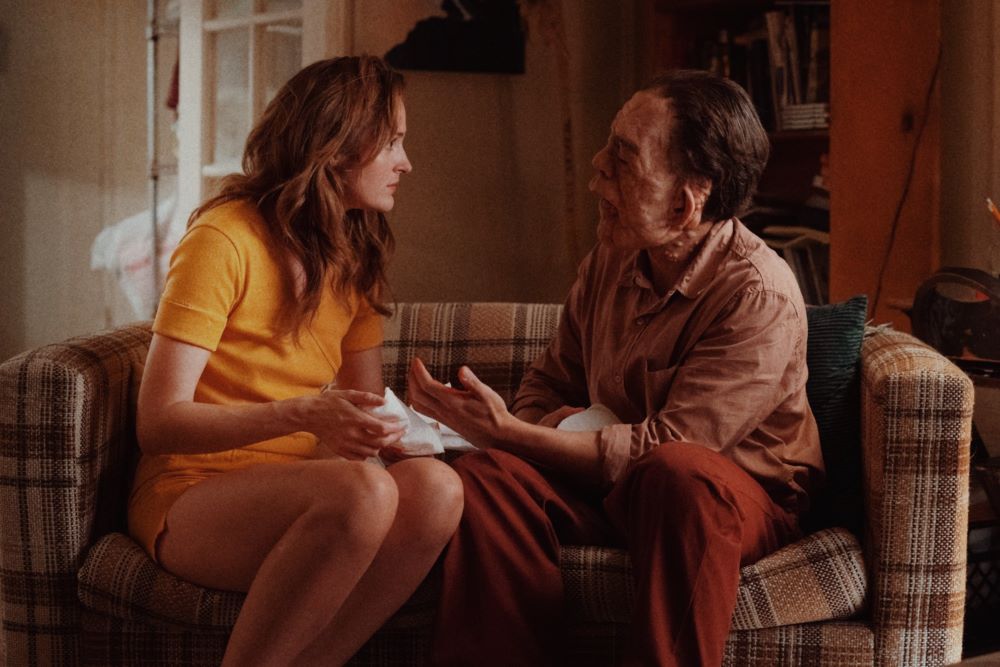Sebastian Stan and Adam Pearson Become A Different Man
New A24 drama finds that wherever you go, there you are
By Richard Whittaker, 2:57PM, Thu. Oct. 3, 2024

When people talk about bad habits, is it the “bad” or the “habit” part that’s worse?
It’s a question that’s fascinated Sebastian Stan as raised in his newest film, A Different Man, now in theatres from A24. “Why do people keep making the same choices, especially later on in life, even though it brings them pain and suffering?”
He makes that rumination as he sits in a private dining room in the Four Seasons, a space that's been converted into a press room. It's the Monday of Fantastic Fest 2024, the night after Stan had been the subject of an unexpected double bill. He’d helped sneak in a print of his new biopic of Donald Trump, The Apprentice, as one of the festival’s secret screenings, but before that he, costar Adam Pearson, and director Aaron Schimberg had been in attendance for the Texas premiere of A Different Man.
In it, Stan plays Edward, a man who has neurofibromatosis or NF1: that’s a genetic condition that can cause disfigurement due to the growth of benign tumors. He undergoes a treatment to cure his NF1, only to find that’s never been the real problem in his life – a realization reinforced when he meet Oswald (Pearson), who also has NF1 but already has the life Edward always wanted. This means Stan wears prosthetics to emulate having NF1 to share a screen with Pearson who actually has NF1. It’s a film that’s intended to provoke conversation, and Stan said he was glad to have been part of the evening’s post-screening Q&A, and others throughout the film’s festival run. He said, “It’s always interesting to get the audience’s questions – what people respond to has been really interesting.”

And complicated questions are an important part of acting for Stan. Aside from achieving blockbuster status as Bucky Barnes, aka the Winter Soldier, in the Marvel movies, he’s also been attracted to morally and emotionally complex characters in films like the award-winning I, Tonya and hangover romance Monday. “There’s a degree to becoming an actor about having a natural sense of curiosity, not only about yourself but about people, but also the degree of a relationship to discomfort. I guess it also has a very narcissistic, self-indulgent piece to it as well and many people go down that route, but I think that at the core it’s about understanding human behavior – at least it is for me.”
At the Fantastic Fest screening, there had been a lot of laughter at the film’s understated dry humor, “and that’s good, I think,” added Stan.
That dryness is a tough balance, Pearson said. “Any step one way and it becomes tragic, and if you go the other way it just becomes nasty. So you’ve got to walk this really fine line to stick the landing, and I think Aaron does that remarkably well.”

A Different Man marks Pearson’s second collaboration with Schimberg, following on from 2019’s Chained for Life. After that film, Schimberg approached him about working together again “and by that point I greatly respected him as both a writer and director, and also as a human – he’s a mate at this point. So I had no trouble pulling the trigger for, ding ding, round two. … If he wants to go with round three, I’m in.” Schimberg sent him the script for A Different Man, “and I think my only notes were, ‘So I have to learn to yodel?’”
Both films look at society’s responses to disfigurement and physical differences through the lens of acting. In Chained for Life, Pearson plays Rosenthal, a jobbing actor just trying to make a living. In A Different Man, Oswald channels the stage lovey, flamboyant and flirtatious, with wardrobe choices that scream for attention. Costume fitting “was such a fun day,” said Pearson, “trying on these whacky clothes.” No piece stands out more than a silk kimono emblazoned with a tiger. “That was one of my favorite outfits, and I tried to keep it, but it had to go back.”
But the script tackles a deeper ethical issue about casting. In A Different Man, post-treatment Edward decides to take the lead in the play about a man with NF1 and wears a mask of his old face when he still had tumors. Meanwhile, Oswald starts circling the part – but is he a better fit because he actually has NF1 or just because he’s a better actor? Stan said, “It’s really clever the way Aaron has weaved this line between the play and reality, and the journey of this man’s suffering at the hands of his own self-abandonment.”

Those questions are implicit outside of the script in the casting of Stan – who has what can only be described as classic movie star good looks – and Pearson, who has become instantly recognizable both as an actor and through his advocacy work for people with disfigurements. Their characters represent a conundrum with which many actors contend with eventually, of the ethics of playing a character with physical differences. For Stan, there’s no hard-and-fast rule. He said, “I think it depends on the script, I think it depends on the character, I think it depends on the story and what it’s asking for. In this case, it’s very clear what Aaron – who is disfigured himself – is asking for and is trying to ask with the film.”
Pearson noted that Schimberg has faced a related conundrum: when he has tried to cast actors with disabilities to play characters with disabilities, he’s been accused of exploitation. These conversations become a Catch-22 situation: cast an actor with a disability and you’re exploiting them, cast an actor without that disability and you’re not providing representation. Either way, the part never gets cast, the story is never told, “and everyone pats themselves on the back,” Stan said, “and no one's learned anything.”
“You can’t do wrong for doing right,” Pearson said, “So in the end, you just say ‘screw it’ and do it”
One of the most dehumanizing parts of society’s treatment of people with disabilities or disfigurements is the idea that anyone with any kind of condition should be living in constant misery. However, there’s a modern twist to that, one that especially affects activists and advocates like Pearson: the idea that they should be constantly happy. That’s why he’s proactive about letting people know when he’s having a bad day. He explained, “I don’t want people to look me up on socials and everything to be ‘Life is great, double thumbs up.’”
Moreover, he works to keep the door open for his friends to let him know if they’re not doing so well. He’s developed a simple technique that maybe could have helped Edward break his own self-destructive cycles. “I always ask twice. When I catch up with my friends I say, ‘Oh, hey, hi, how are you?’ and they go, ‘Oh, I’m fine.’ ‘Oh, I’m sorry, I worded the question wrong. How are you really?’”
A Different Man is in theaters now. Read our review and find showtimes here.
A Different Man
USA, 2024, 112 min.
Texas premiere
A note to readers: Bold and uncensored, The Austin Chronicle has been Austin’s independent news source for over 40 years, expressing the community’s political and environmental concerns and supporting its active cultural scene. Now more than ever, we need your support to continue supplying Austin with independent, free press. If real news is important to you, please consider making a donation of $5, $10 or whatever you can afford, to help keep our journalism on stands.
May 31, 2025
Fantastic Fest, Fantastic Fest 2024, A Different Man, Sebastian Stan, Adam Pearson








